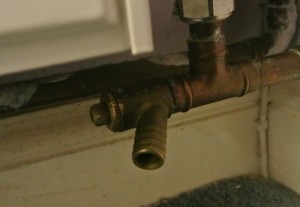 Cleaning the central heating system is not for the faint hearted. It requires time, care and if in doubt contact a reputable plumber. If cleaning the central heating system goes wrong then you could even blow up your house. Several houses in the UK (and I should add usually their neighbours houses) are destroyed this way when there is insufficient water in the system. However all central heating systems need cleaning from time to time*. If done right it suppresses gas production in the radiators, stops corrosion and makes it run more efficiently meaning you should get more heat for the same amount of energy use.
Cleaning the central heating system is not for the faint hearted. It requires time, care and if in doubt contact a reputable plumber. If cleaning the central heating system goes wrong then you could even blow up your house. Several houses in the UK (and I should add usually their neighbours houses) are destroyed this way when there is insufficient water in the system. However all central heating systems need cleaning from time to time*. If done right it suppresses gas production in the radiators, stops corrosion and makes it run more efficiently meaning you should get more heat for the same amount of energy use.
We had our system modified slightly over 10 years ago. We had bigger radiators put in, one more added in a room and moved a small one into the downstairs toilet where there was none. The plumbers concerned noticed that black gunge was coming out of the system. They told me to clean the system out, gave me the materials and told me what to do.
The first thing is switch the gas off completely. Including pilot light if you have one. I’ll say it again switch the gas off completely.
The process takes place in two stages a week apart. The first stage is to add cleaner. All systems have a means of draining them and some kind of header tank. Its vital in any event to know where they are in case of problems. Usually the header tank is going to be high up (in the roof) and for obvious reasons the drain point low down. Our header tank has its own ballcock and is fed from the cold water tank with a valve in between. The drain point is in the sideway (in fact we have two which complicates things massively). The valve is probably under a floor somewhere. Last week I lifted the floor boards opened the drain valve up and the other one underneath a radiator and let the system run until both produced clear water opening up all the radiator valves. I also cleaned out the header tank. Once the water runs clear you need to add the cleaner. The easiest way to do this is is to pour it into the header tank whilst the valves are open. I did this but thought of a more effective way of adding for the inhibitor stage (see below). Quickly close the valves and let the system refill.
At this point the radiators will need refilling. Doing so will pull in any remaining cleaner in the header tank. After this I pumped the system round cold (without my pilot light). I listened to the sound from the pump. Since we have two drain points due to a system extension the pipes go up and then down, we get an airlock at the watershed between the two parts of the system. The way to clear an airlock in a radiator is to switch the valves off at all the unaffected radiators and pump the water round cold. Having done this and having bled the radiators again to make sure they were full I then was ready to relight the pilot light and use the central heating.
You leave the cleaner for a week and use the central heating. Then you do the whole thing again but add inhibitor. In the meanwhile I went to the homebrew shop bought a large piece of silicon tubing. This almost fitted over the exit pipe in the header tank whist the drain valves where open after the water was clear again I held the tubing over the end of the pipe in the tank and poured the inhibitor down the tube meaning almost all of it got into the system.
The only problem I had was with one of the drain valves (shown above) which leaked when closed. I had to get the plumber out to fix it. There are two washers in it. The one furthest back instead of moving with the valve when I undid it stayed put and jammed in the pipe. It was difficult to remove but would have been easy enough to do myself once the system had been drained and replace with a new one.
In my experience this stops gas buildup in radiators and is good for 8 years or so before the system starts to silt up again. Cleaning the central heating system is simple enough to do yourself providing you are careful.
* This blog covers non sealed GCH systems, but presumably electric and ground source heating systems will require cleaning now and again although the dangers are far less. It does not cover the GCH in hard water areas although the inhibitor claims to stop limescale build up. We have no such problems having soft water.
Neil
